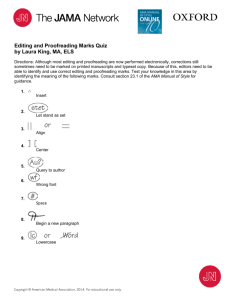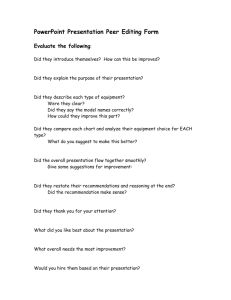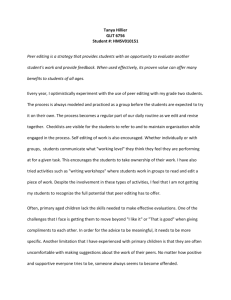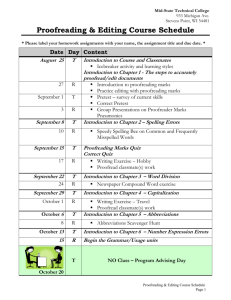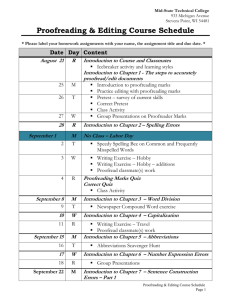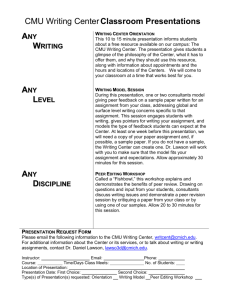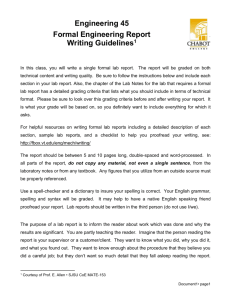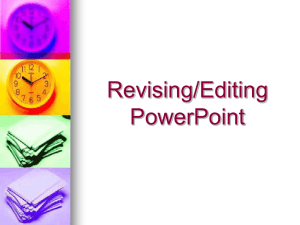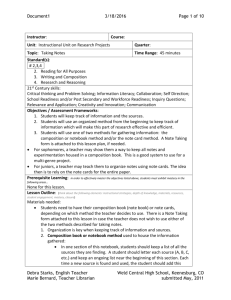Revising, Editing, Proofreading Lesson Plan for High School
advertisement
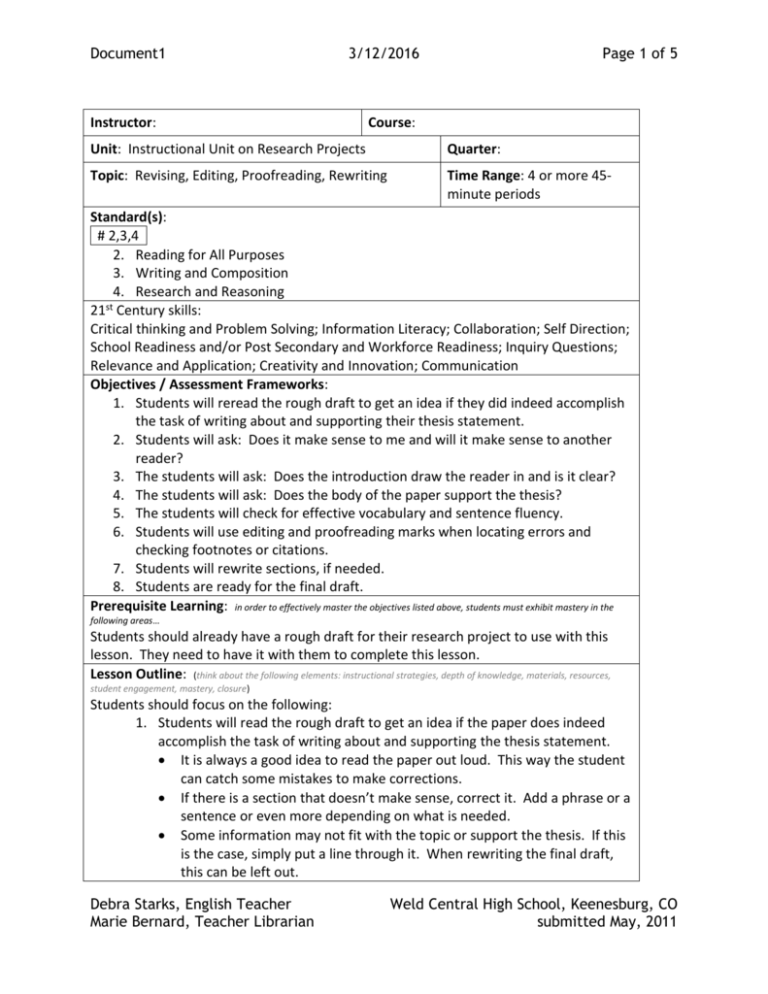
Document1 3/12/2016 Instructor: Page 1 of 5 Course: Unit: Instructional Unit on Research Projects Quarter: Topic: Revising, Editing, Proofreading, Rewriting Time Range: 4 or more 45minute periods Standard(s): # 2,3,4 2. Reading for All Purposes 3. Writing and Composition 4. Research and Reasoning 21st Century skills: Critical thinking and Problem Solving; Information Literacy; Collaboration; Self Direction; School Readiness and/or Post Secondary and Workforce Readiness; Inquiry Questions; Relevance and Application; Creativity and Innovation; Communication Objectives / Assessment Frameworks: 1. Students will reread the rough draft to get an idea if they did indeed accomplish the task of writing about and supporting their thesis statement. 2. Students will ask: Does it make sense to me and will it make sense to another reader? 3. The students will ask: Does the introduction draw the reader in and is it clear? 4. The students will ask: Does the body of the paper support the thesis? 5. The students will check for effective vocabulary and sentence fluency. 6. Students will use editing and proofreading marks when locating errors and checking footnotes or citations. 7. Students will rewrite sections, if needed. 8. Students are ready for the final draft. Prerequisite Learning: in order to effectively master the objectives listed above, students must exhibit mastery in the following areas… Students should already have a rough draft for their research project to use with this lesson. They need to have it with them to complete this lesson. Lesson Outline: (think about the following elements: instructional strategies, depth of knowledge, materials, resources, student engagement, mastery, closure) Students should focus on the following: 1. Students will read the rough draft to get an idea if the paper does indeed accomplish the task of writing about and supporting the thesis statement. It is always a good idea to read the paper out loud. This way the student can catch some mistakes to make corrections. If there is a section that doesn’t make sense, correct it. Add a phrase or a sentence or even more depending on what is needed. Some information may not fit with the topic or support the thesis. If this is the case, simply put a line through it. When rewriting the final draft, this can be left out. Debra Starks, English Teacher Marie Bernard, Teacher Librarian Weld Central High School, Keenesburg, CO submitted May, 2011 Document1 3/12/2016 Page 2 of 5 2. Does it make sense to the writer and does it make sense to another reader? Peer editing can be fun and helpful to students. It is always good to have someone else read what is written to see if it makes sense. o There are a variety of ways to conduct peer editing sessions. o The goal is for the responder to be professional and point out areas that seem confusing or that could be improved. o Ask the peer editor to focus on certain areas when reading or listening. For example, ask the peer editor to react to the organization, or to the sentence fluency or to the word choice. As the writer, listen to the peer editor and then decide whether or not to incorporate the suggestions. It is always good to get feedback from more than one other person. As a teacher, it might be helpful to model this with the class before giving them time to peer edit. 3. ASSIGNMENT: Either the student or the peer editor should write down some comments about what was said or about the process and turn in for credit. 4. Spend some time concentrating on the different parts of the paper. Does the introduction draw the reader in, and is it clear? Is there an attention-getter? Is there enough background information to inform the reader about the topic? Is there a solid thesis statement that tells the reader what the paper is addressing? 5. ASSIGNMENT: Students should show the teacher the revised introduction of their paper for credit. 6. Does the body of the paper support the thesis? Are there good topic sentences followed by details in each of the body paragraphs? Is it a good idea to check each sentence to make sure it supports the thesis. If needed, adjust wording slightly so it supports the main idea well. 7. Is the vocabulary effective and does the writing have sentence fluency? Be sure to use a dictionary or a thesaurus, when needed. Be specific with nouns and verbs. Word choice can make a huge difference in a reader’s impression and understanding. Remember that spell check does not catch everything. Use a variety of sentence lengths. Reading aloud helps to notice whether sentence fluency exists. Don’t make it sound choppy. 8. ASSIGNMENT: Find five words to improve. List these words plus the new improved vocabulary words to turn in for points. This could be done on a post-it and used as a ticket out the door. Debra Starks, English Teacher Weld Central High School, Keenesburg, CO Marie Bernard, Teacher Librarian submitted May, 2011 Document1 3/12/2016 Page 3 of 5 9. Use editing and proofreading marks when locating errors; check footnotes or citations. (Teachers: It will be helpful to give students a copy of these marks). A copy of proofing marks is attached to this lesson. When editing a paper, look for punctuation errors. o Often times, compound and complex sentences do not have commas used correctly. Check sentences where conjunctions are used, and make sure to use a comma following an introductory clause. (. . . , but ...) o If using parenthetical citations, check punctuation. The end mark is usually placed outside the parentheses. (400). o Remember to use quotations marks on exact words from the sources. Look for capitalization errors. o Names and specific places are always capitalized. o When referring to someone famous, use their last name, not their first. (Benjamin Franklin can be referred to as Franklin, but never Ben or Benjamin) o Begin each sentence with a capital letter. Look for spelling errors. o Double check words if unsure. o Get help in finding mistakes through peer editing (ask someone who is a good speller to help locate these errors). Look for grammar errors such as: verb usage, subject verb agreement problems, and the correct form of “there, their, they’re”. 10. ASSIGNMENT: When turning in the rough draft, the teacher will look for evidence of these proofreading and editing marks and other marks needed for a final draft. Points will be given for evidence of proofreading and editing. If the rough draft has no evidence of proofing, no points will be awarded. 11. Rewrite sections, if needed. If sections are confusing or need major overhaul, rewrite them, so it is not confusing. Then recheck again before tackling the final draft. 12. Now for the final draft. The final draft needs to be as clean as possible (free from errors), so the reader will not be distracted by any mistakes. The reader needs to be able to read and understand the writing without distractions, so he/she can focus on the meaning and the excellent ideas written. 13. This final draft may take 4 or more days to complete. notes: Differentiation: use the data (CSAP, Acuity, TOSCRF, YPP…) collected to help identify how you will meet the needs of all students in your class. Individual students may need different types of help along the way depending on their strengths and weaknesses. Debra Starks, English Teacher Marie Bernard, Teacher Librarian Weld Central High School, Keenesburg, CO submitted May, 2011 Document1 3/12/2016 Re-Teach Extensions Page 4 of 5 Accelerations (Distributive Practice) Footnotes & parenthetical references (students need multiple practices) Students should find this process helpful for all classes. Each student writes to his/her level. Evaluation / Assessment: explain how you will determine mastery of this lesson to the objective/standard… Each of the first three assignments are good indicators illustrating progress. Reflection: Things that went well… Students were seeing a “light at the end of the tunnel” and showed excitement. Students enjoyed reading and editing their peer’s works. Having short steps made the process less overwhelming. Things that didn’t go well… Not all students mastered the proper use of footnotes and parenthetical citations . Attendance is a problem; when students are absent, lessons are missed and assignments are not being completed on time. This makes it more difficult to continue with the next lessons, when the assignments need to be in their hands. Things to remember… This whole process will be completed and comprehended differently. Each student may have a different level of understanding for each step in the process. Things to change for next time… More direct assignments for using footnotes and parenthetical citations need to be practiced more often and earlier. Possibly incorporate an assignment with an advanced English class doing critical reviews for underclassmen. A thought to help with reviews of lessons: ask students to review the major points from a specific lesson. Debra Starks, English Teacher Marie Bernard, Teacher Librarian Weld Central High School, Keenesburg, CO submitted May, 2011 Document1 3/12/2016 Page 5 of 5 The following picture was taken from: http://www.eeicom.com/staffing/marks.html Debra Starks, English Teacher Marie Bernard, Teacher Librarian Weld Central High School, Keenesburg, CO submitted May, 2011
